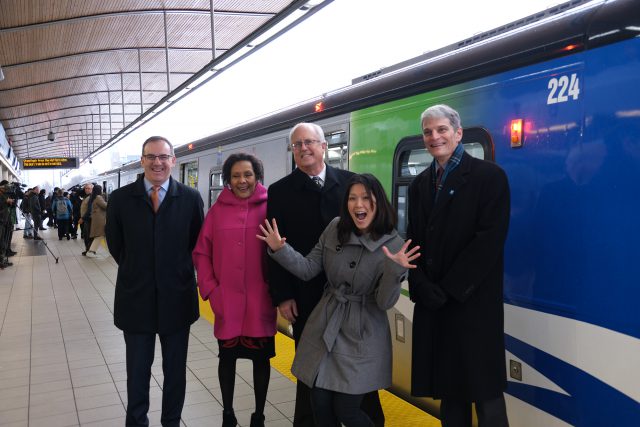New Canada Line trains increase service for customers
New Canada Line trains increase service for customers


Four new Canada Line trains begin service today, increasing customer capacity by 15 per cent during peak hours. The brand-new trains will provide more space, frequency and comfort to customers.
These are the first of 12 new trains, which are being rolled out as part of Phase One of the Mayors’ 10-Year Transit Expansion Plan. Once more trains are in service later this year, there will be a total increase in capacity of approximately 35 per cent compared to 2019 service levels.
Delivered through the Public Transit Infrastructure Fund (PTIF), this $88 million investment is funded 50 per cent by the Government of Canada, 33 per cent by the Province of British Columbia, and 17 per cent by TransLink.
To support this increase in service, the Canada Line Operations and Maintenance Centre was upgraded and three additional escalators were installed at Canada Line Stations in 2019. This $36 million investment was also funded through PTIF.
The remaining trains are in the process of being delivered from Hyundai Rotem in South Korea. Upon arrival, the new trains will go through testing and commissioning before being certified for revenue service later this year.
Quick facts:
- In 2019, for the first time, there were more than 50 million boardings on the Canada Line
- With more than 150,000 trips taken on an average weekday in 2019, that is an increase of about 3 per cent compared to 2018
- Canada Line is a 19-kilometre route with 16 stations, two bridges and nine kilometres of tunnel
- 21 per cent of travellers use the Canada Line for their journey to or from YVR
- Improving transit and transportation infrastructure is a shared priority between government and the BC Green Caucus, and is part of the Confidence and Supply Agreement
Quotes:
Honourable Catherine McKenna, Minister of Infrastructure and Communities –
“Good public transit builds strong communities and helps create jobs. Adding more trains on the Canada Line will help residents by providing more frequent service. Our historic investments in transit infrastructure are making a real difference in the lives of the people of Metro Vancouver.”
Bowinn Ma, Parliamentary Secretary for TransLink –
“The addition of these new Canada Line cars will help more people get to where they need to go faster, whether it is downtown Vancouver, YVR or Richmond, letting them avoid congestion and giving them more time to spend with friends and family. This service increase is one more example of how our shared goal of reliable and efficient transit is making a difference for people. Our government’s commitment to fund 40% of the capital costs of each phase of the Mayors’ Council’s 10-Year Vision will result in continued transit improvements throughout the region making life better for everyone.”
Malcolm Brodie, Mayor of Richmond –
“Since its inception just before the 2010 Olympics, the Canada Line has played a vital role in the development and growth of Metro Vancouver. Investments like these not only make our transit system more accessible and enjoyable, but it also ensures that we can keep up with the demand as more people are choosing to take transit to get to where they need to go.”
Kevin Desmond, CEO, TransLink –
“The Canada Line is an integral part of the transit system and its booming ridership reflects that. Ridership has been strong since it opened, and regular weekday ridership has grown 25 per cent since then. This increase in service and the upcoming increase later this year will provide relief to our customers who depend on the Canada Line every day.”






You assume everyone knows a train is two cars.
Why not a fuller description “ four , two cars trains have been added”
What’s the new headway during peak hours now?
What is the passenger capacity (pphpd) once all additional trains are in service (32 trains total)?
@Mark L
I believe that they have previously announced that when all the new trains arrive, the system will operate at a peak headway of 2m30s. This translates to 24 trains per hour per direction, which is around 8000 pphpd as each train has a capacity of 334 passengers.
The maximum headway with all 32 trains is 2 minutes, or 30 trains per hour per direction, or 10000 pphpd. I don’t think this will happen in 2020 as their plan is likely to slowly increase capacity as needed over time. To increase beyond 10000 pphpd, longer trains will have to be obtained.
In comparison, I think that in Dec 2019, the peak headway was 3m8s, or 19 trains per hour per direction, or just over 6300 pphpd.